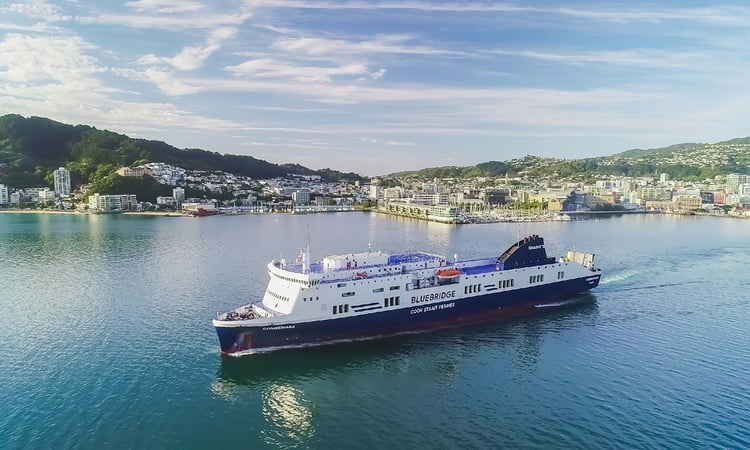
Planning a motorhome adventure across two geographically different islands seems more adventurous than exploring only one. Thankfully, New Zealand’s ferries can move you and your recreational vehicle between Wellington and Picton with ease.
The ferry will leisurely take you across the Cook Strait and likely become a holiday highlight.
In this guide, we talk about everything you need to know to take your motorhome hire from north to south — or south to north.
Find out about the cost of Cook Strait ferry tickets, how to book them and the process of taking your campervan onboard. Plus, we share scheduling information, amenities details and top tips for crossing the Strait.
|
Contents |
How to book Cook Strait ferry tickets
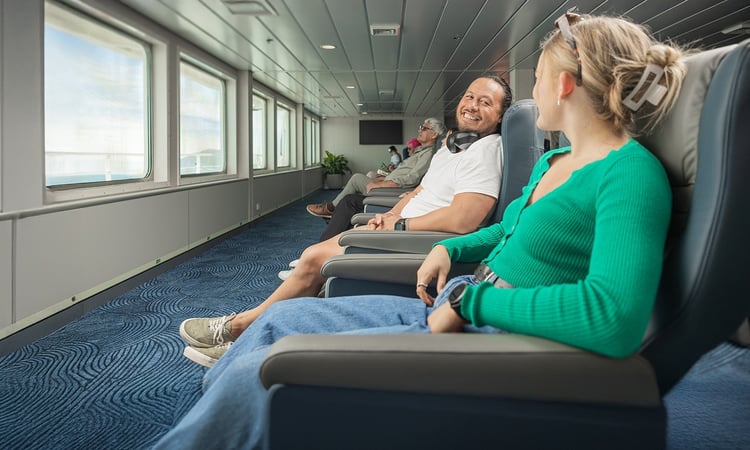
You have two ways to go about securing tickets for you and your motorhome across the scenic Cook Strait — whether you plan to travel from Wellington to Picton or vice versa.
Booking Cook Strait ferry tickets indirectly
The easiest way for you to book your passage across Cook Strait when hiring a Wilderness motorhome is to let Wilderness book ferry tickets for you.
As an agent for the Cook Strait ferry, we can:
-
Organise fully flexible fares for you
-
Change your tickets at no extra cost — up to 24 hours before sailing
-
Assist you with rebooking your fare — when services are cancelled due to ferry breakdowns or bad weather.
Booking Cook Strait ferry tickets directly
If you decide to book directly, visit the Cook Strait ferry website and be sure to book a ticket for your motorhome rental and each passenger. Once you’re on their site, follow these steps:
-
Click on the booking page — and select your preferred route and date
-
Enter all your passenger details — the number of adults, children, infants, seniors and students
-
Check the vehicle box — and select Motorhome / Campervan
-
Type in the length of your motorhome in metres — Wilderness motorhome hires are either 5.9, 6.7, 7 or 7.4 metres long and are easily visible on our product range page
-
View the available sailings — choose the ticket type you want and click next - extras
-
Add any additional items you require during your ferry trip and click continue
-
Enter your and your passengers’ contact details and click continue
-
Select whether you want insurance cover, choose how to pay, check the terms and conditions and click pay in full
-
Fill in your payment details — your booking confirmation will come through via email.
Cook Strait ferry ticket prices
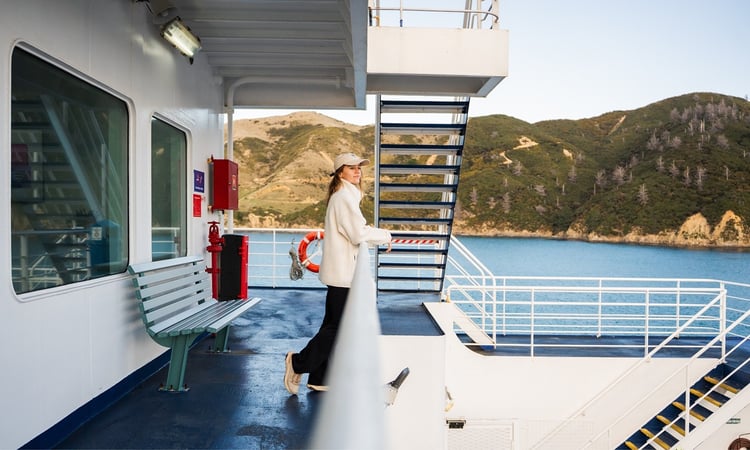
The cost of taking your campervan hire or motorhome rental across Cook Strait depends on a number of factors, including:
-
The time of year you want to travel — expect to pay more during peak season between December and March
-
The length of your vehicle — it’ll cost you progressively more, the longer your vehicle.
Find out more about New Zealand weather across the seasons.
Whether you choose Bluebridge or Interislander, our flat rates are $89 per adult and $47 per child.
For your vehicle, pricing is based on length:
-
Up to 6m: from $294
-
6.5m – 7m: from $390
-
7.0m – 7.5m: from $433
You can also choose to travel in comfort with a Lounge pass or a Standard Cabin for an additional $98. Rates can change, so please contact our reservations team for the most current pricing.
Taking your motorhome on the Cook Strait ferry
Both ferry terminals are easy to find in Wellington and Picton. The signage coming into Wellington on State Highway 1 and State Highway 2 is very clear. Simply follow the directions and you’ll arrive at the check-in area.
Both the north and south terminals have queues for larger vehicles, including motorhomes. You’ll need to be at the ferry terminal at least one hour before your scheduled departure. But consider arriving even slightly earlier for peace of mind and to be able to drive onboard sooner.
Checking in
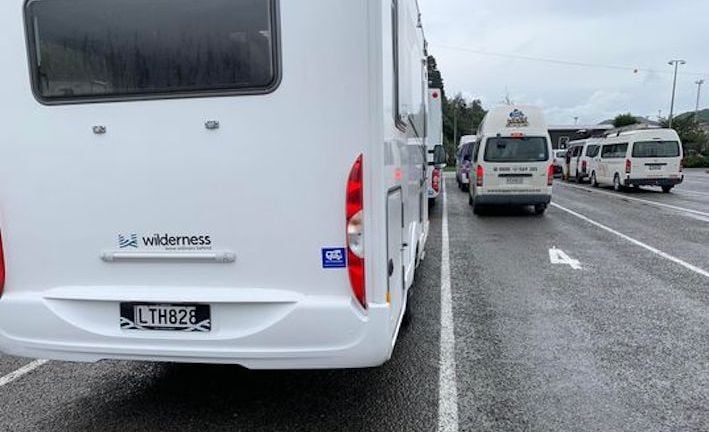
The check in process is a breeze as you choose the lane that fits your vehicle type, then follow the queue up to the drive-through ticket booth.
Ensure you have your ticket or reference number ready on your mobile device. After you check in, you’ll be directed by ferry staff to the correct boarding queue lane.
Be aware that the maximum speed once you’re inside the terminal grounds (and on the ferry) is a leisurely 10km/h.
Parking up and preparing to sail
You’ll be clearly directed which way to drive onboard and where to turn and park. Don’t worry about the linkspan (drawbridge) as it’s sufficiently flat to avoid scraping the bottom of your motorhome when embarking or disembarking.
Once parked up, take your time to gather any important items you’ll need on the passenger deck, such as your:
-
Mobile phone, payment cards, cash and your passport or other ID
-
Laptop — or any work material
-
Food and any medication
-
Motorhome keys.
|
Crossing the Strait Cook Strait can be a choppy stretch of water and it’s sometimes hard to know what conditions will be like. If you’re planning to spend time outside on the promenade or top decks, be sure to carry sunscreen, warm clothing, a secure hat, rainwear and even binoculars. |
Remember to lock your vehicle, as you won’t be allowed to return to it until the ferry docks at its destination. You’re then free to head upstairs to the passenger decks to explore what the Cook Strait ferry has to offer and to enjoy the cruise.
Disembarking
As your ferry reaches its destination, listen for an announcement over the speaker system letting drivers know to get ready to return to their vehicles. Follow the lead of staff and other drivers to make your way back to your motorhome or campervan rental.
Once back on the road, take a look at our best campervan sites to park up in New Zealand.
Cook Strait ferry schedule and route
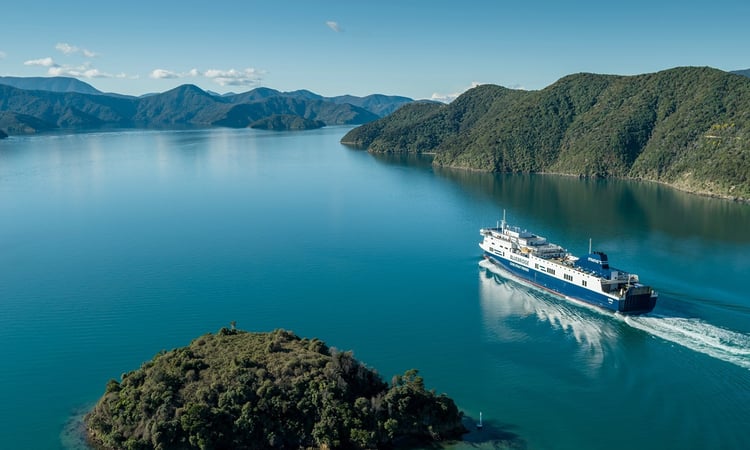
Under the Bluebridge brand, two passenger ferries normally service the Cook Strait route.
Interislander is New Zealand’s other passenger ferry company, with three ships that transport people across the channel.
Scheduling
As with pricing, the scheduling of ferry services is dependent on varying demand across low and high seasons.
On most days, the Bluebridge Cook Strait ferry has eight sailings across the channel, with four departing from Wellington and four from Picton. The Interislander only has six — three from both Picton and Wellington. These numbers are the same across all seasons, though some days of the week have fewer sailings.
Your journey time
Depending on the weather conditions, your journey will take approximately three and half hours to cover 50 nautical miles — which is the equivalent of 93km (58 miles) on land.
Smooth sailing conditions could mean your travel time is cut a little while rough sea conditions may see it take longer.
Your route
Taking the Cook Strait ferry trip from north to south, you’ll begin sailing through Wellington Harbour, where you can enjoy superb views of the city, Mount Victoria and the eastern bays.
Around an hour into your voyage, the majestic Pencarrow Lighthouse will see you off into the Cook Strait. Barrett’s Reef may also be visible underwater, while Wellington’s quintessential seaside suburbs are well worth your viewing time.
It will take another 75 minutes or so to cross the Cook Strait, which is obviously the most exposed section of the cruise. Walk up to the top deck, and you might see dolphins frolicing in groups, seabirds soaring past or seals basking on rocky outcrops.
Following the crossing, you’ll enter the Marlborough Sounds through what seems like an incredibly narrow gap between bays. Expect to sail for a further 75 minutes via Queen Charlotte Sound into Picton with the most picturesque scenery of the entire journey over this part.
Be on the lookout for:
-
The remains of a whaling station
-
Mussel farms
-
Regenerating native bush
-
Hidden bays — only accessible by sea.
Amenities on the Cook Strait ferries

Bluebridge’s two ferries on the Cook Strait route are Connemara and Livia. Livia arrived in 2025 to increase fleet capacity and replace the older ferry in service.
Each vessel offers breathtaking landscape scenery from various indoor seating areas and from outside on their decks. Onboard, you’ll also be able to enjoy:
-
Fully licensed food outlets — including food courts, cafés and bars
-
Movies in the cinema
-
Pohutukawa lounge (R16)
-
Free WiFi — to keep yourself entertained or catch up on work
-
Activities for younger travellers — especially in summer and school holidays, with magic shows and face painting common attractions.
It’s also possible to book a cabin if you’d like some privacy or a snooze as you cruise.
When you’re back on the road, visit some of the country’s best farmers’ markets.
Top tips for crossing Cook Strait on the ferry
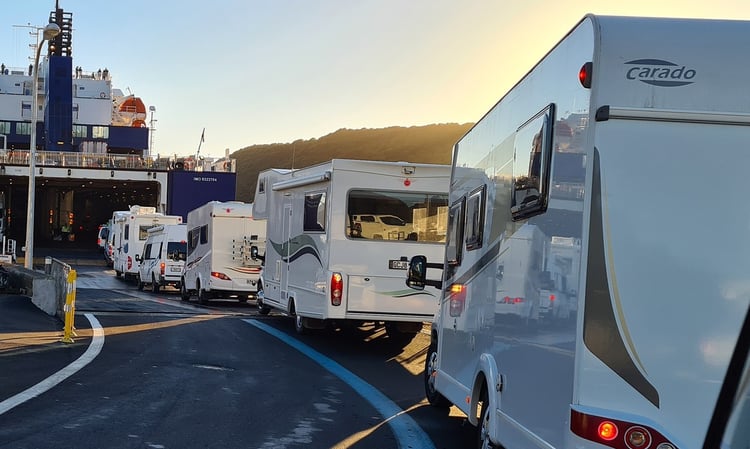
Like any type of travel (by air, road or sea) it’s helpful to have the inside word on what can make your journey better. We share our best tips for enhancing your adventure across the body of water that connects New Zealand’s two main islands.
Sail by day
To fully appreciate the breathless views, book a daytime sailing for your group. They’re a little pricier than cruising by night, but the scenery is absolutely worth the extra few dollars — with seabirds, seals, dolphins, and sometimes even whales joining the trip.
Book in advance
To be sure you won’t miss out on the date and time of sailing you prefer it’s best to book well in advance. This is particularly the case if your plans are over summer from December to February, or during New Zealand school holidays.
Take time before continuing your journey
One quirk with the way transport is loaded on and off the Cook Strait ferries is the positioning of the big rig trucks to exit first. This can create a bottleneck driving south from the Picton terminal — so if the timing’s right, spend an hour or two in town enjoying a meal or playing minigolf. Then continue your road trip on a more tranquil highway.
Wellington doesn’t tend to have this issue as the multi-lane motorway passes right by the terminal.
Avoid seasickness
On rare occasions, the crossing between north and south can get rough, so if you’re prone to seasickness, consider taking motion sickness tablets before sailing.
Fresh air is best if you're feeling a little nauseous, so head to the top deck where you'll be able to breathe in the sea breeze and see the horizon.
Remember where you park
It’s worth mentioning to make a mental note of exactly where you park your motorhome hire on the Cook Strait ferry. These are large vessels with multiple floors — and returning to your vehicle only to realise you’re not sure where you parked it is never fun.
-
Near Wellington, try Wellington Top 10 (Petone) or Paekakariki Holiday Park. For nature lovers, Kaitoke Regional Park is a peaceful option. In Picton, the Tasman Holiday Park is ideal for convenient access (5 mins to terminal), while Smiths Farm Holiday Park offers a peaceful, scenic stay just a 30-minute drive away.
Learn more about travelling on the Cook Strait ferry with a motorhome in NZ.




